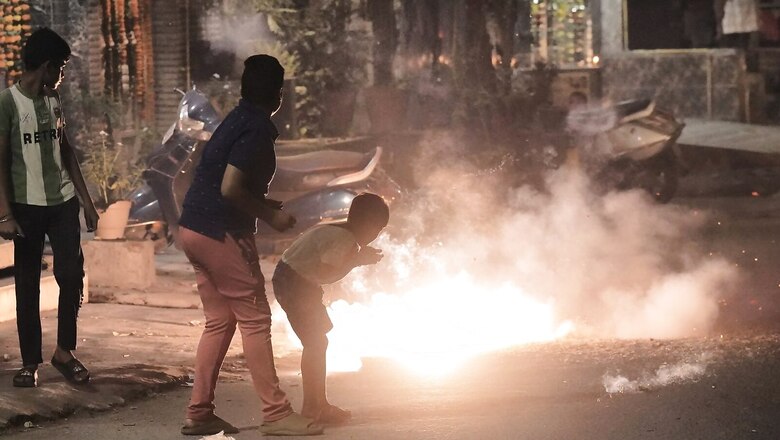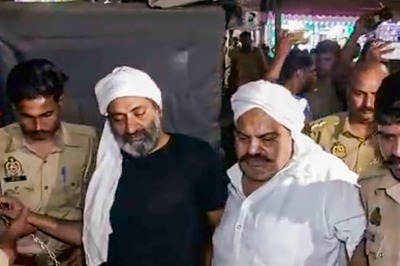
views
The morning after Diwali, Delhi is seeing ‘very poor’ air quality at most stations. According to data computed by the Central Pollution Control Board, the Anand Vihar station saw an AQI of 363, with many people having flouted the cracker ban imposed by the Delhi government.
The System of Air Quality and Weather Forecasting And Research (SAFAR) said the national capital’s air quality index is presently at 323 (overall) in the ‘very poor’ category.
Delhi Environment Minister Gopal Rai last week said bursting firecrackers in the national capital on Diwali will attract a jail term of up to six months and a fine of Rs 200. Despite the legal deterrent in place, people in many parts of the city, including in south and northwest Delhi, started bursting crackers by dusk. High-intensity firecrackers could be heard going off on the ground or mid-air.
The station at CRRI Mathura road saw a ‘very poor’ AQI at 346 on Tuesday morning, and other stations saw similar figures, as well.
On Monday, as the night progressed the intensity of firecrackers increased breaching permissible decibel limits, prompting some to wonder “if there was any ban at all”. Bursting of firecrackers on Diwali is an age-old tradition, but authorities in Delhi said the decision to restrict it was taken after considering environmental concerns and health hazards associated with it. Delhi’s air quality had turned “very poor” on Monday amid an increase in stubble burning, bursting of firecrackers and moderately unfavourable meteorological conditions which allowed the accumulation of pollutants.
However, the 24-hour average air quality index (AQI) of 312 was still the second-best for Diwali in seven years. The city recorded an AQI of 281 on Diwali in 2018. Earlier in the day, experts feared that if the volume of firecrackers burst goes up again this year, the air quality is likely to dip further. In case firecrackers are burst like last year, the air quality may plunge to “severe” levels on the night of Diwali itself and continue to remain in the “red” zone for another day, the System of Air Quality and Weather Forecasting and Research (SAFAR) had earlier predicted. Notwithstanding the ban, people burst firecrackers with impunity in various areas, starting around 6 pm.
In south Delhi’s East of Kailash, and neighbouring places like Nehru Place and Moolchand, firecrackers going off mid-air could be heard in the evening. Some residents burst crackers in their neighbourhood like every year. In Burari too, many residents burst firecrackers despite widespread dissemination of information about the ban. “They are educated but still doing this, what will children learn from it,” a resident of a colony in Burari told PTI. In Laxmi Nagar, Mayur Vihar and Shahdara in east Delhi, the situation was similar. While the intensity in the late evening was lower compared to last year, it rose after 9 pm.
“It was as if the slog overs have started,” a Laxmi Nagar resident told PTI.
Many people complained of itchy skin and a burning sensation in their eyes due to smoke from bursting firecrackers. “I will not step out tomorrow, I know what the air quality will be tomorrow,” said Reetu Nandan, a student, who lives in south Delhi.
Delhi Environment Minister Rai had earlier said production, storage and sale of firecrackers in the city will be punishable with a fine of up to Rs 5,000 and three years in jail under Section 9B of the Explosives Act. A total of 408 teams had been set up to implement the ban.
The Delhi Police set up 210 teams under assistant commissioners of police, while the revenue department set up 165 teams and the Delhi Pollution Control Committee 33 teams. In neighbouring cities of Gurugram and Faridabad too, many people burst firecrackers. The air quality in Ghaziabad (301), Noida (303), Greater Noida (270), Gurugram (325) and Faridabad (256) was reported in the ‘poor to very poor’ category on Monday.
An AQI between zero and 50 is considered “good”, 51 and 100 “satisfactory”, 101 and 200 “moderate”, 201 and 300 “poor”, 301 and 400 “very poor”, and 401 and 500 “severe”.
With inputs from PTI
Read all the Latest India News here


















Comments
0 comment